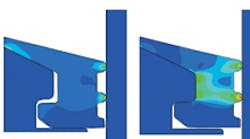Finding the Best Design Fast
Authored by: Jim Soltisz Edited by Leslie Gordon |
According to the father of the bell curve, Johann Carl Friedrich Gauss, variation is to be expected within the range of what is considered normal. Engineers who fail to account for manufacturing variation can make products that don’t meet specifications. Problems might include high amounts of scrap and variations in the operating performance of the manufactured product. A good way to eliminate these problems is to optimize designs while taking manufacturing variability into account.
Engineers first began optimizing linear-FEA models in the 1980s. In aerospace, for example, optimization minimized weight or ensured structural margins were met on specific loads. Nonlinear analyses for evaluating complex manufacturing processes such as material forming became feasible only with the advent of high-performance computing (HPC). HPC involves supercomputers and computer clusters that solve advanced computation problems.
When building FEA models to simulate nonlinear behavior, engineers can modify geometry and materials, by hand, to improve performance. But this approach is slow and error-prone. In contrast, optimization software accounts for hundreds, even thousands, of design possibilities, generating results five to 10 times faster and eliminating human error. Shortening the design cycle this way typically improves performance, reliability, and durability from 5 to 20%, and it lowers cost.
Speedy optimization involves the use of software which automatically and systematically alters variables in designs undergoing FEA. The user’s choice of Monte Carlo, Design of Experiments (DOE), or other Six Sigma method is linked to the FE analysis to evaluate results against real-life criteria such as which model provides the best performance or which design will cost the least to manufacture. The goal of the exercise is to identify the design that comes closest to being the best in real-life operating conditions.
Optimization also pushes manufacturing engineers out of their ruts. Engineers often design based on previous experience with similar tasks. Mathematical algorithms, though, are entirely objective and neutral. They don’t “know” whether the design is for an airfoil or a beam, using only the selected target performance as a guide.
An important task when setting up an optimization study is to choose appropriate design variables. Optimization software helps users manage these variables with either standard or custom workflows that help guide the process. Once all the variables are identified, the software provides the meshing and solvers that produce thousands, even hundreds of thousands, of FE analyses.
In optimization, the “no- free-lunch-rule” obviously comes into play. It is well understood that improvements in one attribute are inevitably paid for with a corresponding decline in another. But the software compares information within an optimization run to whittle the vast set of solutions into a refined subset from which to choose the answer.
A relatively simple optimization exercise uses Abaqus FEA software to design a medical syringe. A syringe plunger is rarely pushed exactly along the tube’s center axis. Different users exert different pressures. There are also variations in the load along the walls of the syringe, which can result in leaks during injection. The Isight DOE algorithm evaluated relevant combinations of the plunger geometry under a variety of side loads. The FEA software identified the maximum syringe pressure for each variation. Results showed a wider plunger yields higher operating pressures and thus prevents leaks under most operating conditions.
Performing a full-blown FE analysis of every possibility in this case would have consumed too much time. The software creates a “response surface,” an approximate point-space defined by results from running (in this case) 50 iterations of the FEA model. The software interpolates results from the surface, without actually creating every theoretically feasible model, to identify the best solution.
Optimized simulation can even be applied beyond product design to improve manufacturing. Material data, machine set points, and proximity sensor data can be considered as design variables for simulating machine tools. Such simulations can be used to prevent jammed tools and missed production deadlines.
